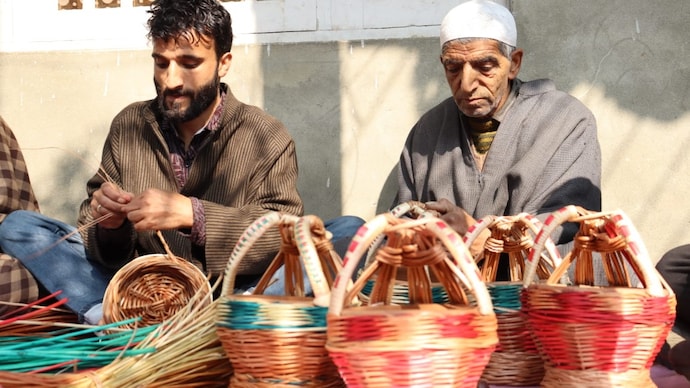As the icy grip of winter tightens over the Kashmir valley, the village of Wokai stands as a beacon of warmth and resilience. Here, amidst the snow-laden landscape, skilled artisans are tirelessly working to produce 5,000 Kangris each day, traditional fire pots that have been an enduring symbol of Kashmiri culture for centuries.
The Kangri, a portable earthenware pot encased in a beautifully woven wicker basket, serves as a personal heater, tucked within the folds of a woolen cloak to combat the biting cold. Each Kangri is a masterpiece of craftsmanship, intricately woven in four distinct styles: Graes Kanger, Khoja Kanger, Mahren Kanger, and Sur Kanger. Each style boasts its unique charm and caters to a diverse range of preferences, reflecting the rich tapestry of Kashmiri traditions.
Mohammad Jamal Shaksaz, a seasoned craftsman, proudly shares the village’s dedication to preserving this age-old tradition. “Every day, we produce between 3,000 and 5,000 Kangris,” he says, his eyes twinkling with pride. “Our Kangris reach every corner of Kashmir, from Kupwara to Qazigund, bringing warmth and comfort to countless homes.”
In Wokai, the art of Kangri making is deeply embedded in the fabric of community life. Families work together, cultivating the necessary ‘Kani’ or twigs in nurseries and meticulously transforming them into these cherished fire pots. The entire process is a testament to the village’s unwavering commitment to safeguarding its cultural heritage.
Despite the thriving local business, Shaksaz expresses concerns over the lack of government support. “Financial aid would greatly enhance our ability to expand the Kangri industry and reach even more people,” he explains. “However, banks often require government employees as guarantors for loans, and even then, the interest rates are high.”
Aqib Rasool, a local Kangri distributor, echoes Shaksaz’s concerns while acknowledging the resilience of the Kangri tradition. “This season’s harsher-than-usual cold has led to increased sales,” he says. “Every day, we distribute around 4,000 to 5,000 Kangris to different parts of J&K.”
In the face of competition from modern heating devices, Rasool emphasizes the enduring appeal of Kangris. “Their reliability and safety are unmatched,” he asserts. “Kangris do not depend on electricity and are free from the risks of electrical faults, making them a preferred choice for many Kashmiris.”
As the winter deepens, the artisans of Wokai remain steadfast in their mission to keep Kashmir warm. Their unwavering dedication ensures that the traditional Kangri will continue to be an integral part of Kashmiri culture, a symbol of resilience and a source of warmth for generations to come.
